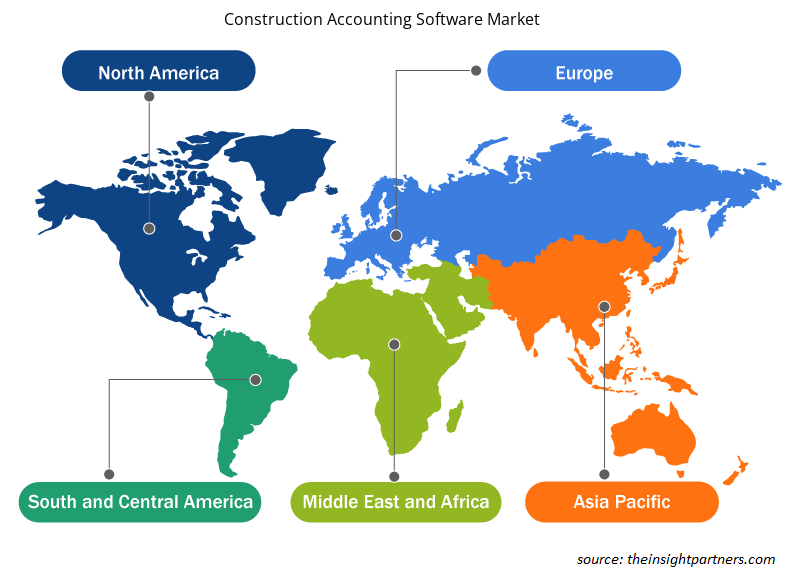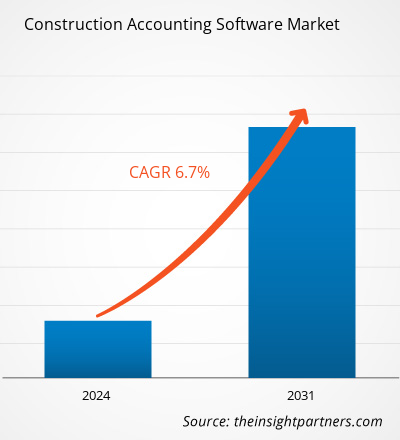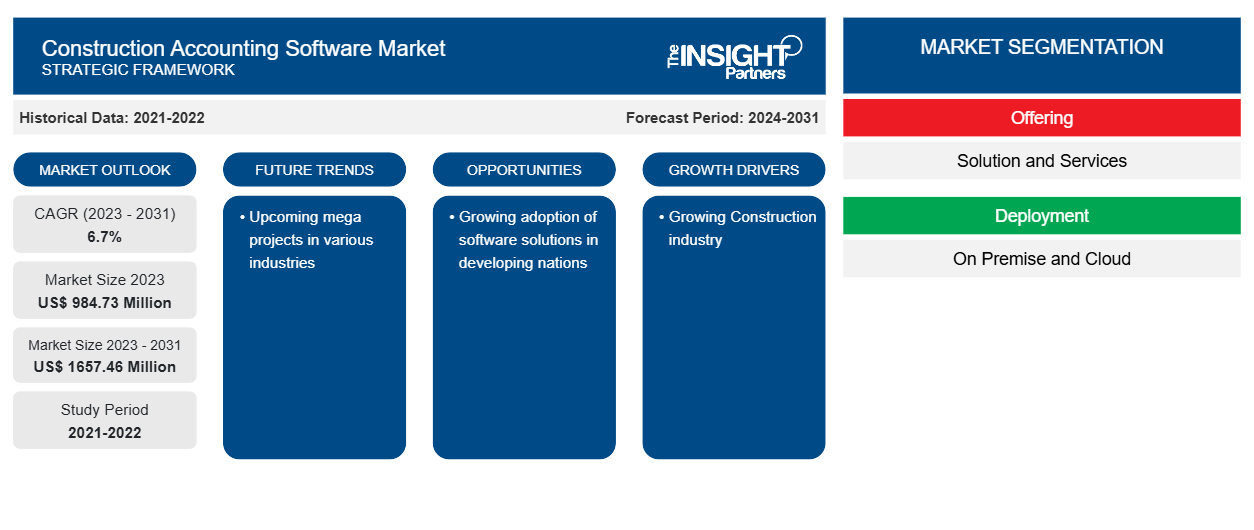Si prevede che la dimensione del mercato del software di contabilità edile raggiungerà 1657,46 milioni di dollari entro il 2031, rispetto ai 984,73 milioni di dollari del 2023. Si prevede che il mercato registrerà un CAGR del 6,7% nel periodo 2023-2031. La crescente digitalizzazione nel settore edile e l'industria edile in crescita rimarranno probabilmente tendenze chiave nel mercato.
Analisi di mercato del software di contabilità edile
La crescente domanda da parte dei settori residenziale e commerciale alimenta la crescita del settore edile. Questo fattore sta portando all'adozione di software di contabilità edile da parte della gestione finanziaria delle aziende edili. Il software aiuta le aziende edili a tracciare con precisione il denaro in entrata e in uscita dalle loro attività. Il software gestisce aspetti del settore edile, come la determinazione dei costi di commessa e la ritenuta. Tali caratteristiche del software di contabilità edile ne hanno portato all'adozione.
Panoramica del mercato del software di contabilità edile
Il software di contabilità edile fornisce strumenti di gestione finanziaria alle piccole e medie imprese edili e alle grandi imprese edili per progetti e attività di costruzione. Questa soluzione software offre funzionalità quali buste paga, costi di commessa, contabilità generale, conti da pagare e da ricevere (AP/AR), reportistica di audit e altro. Alcune soluzioni di contabilità edile si concentrano su informazioni finanziarie specifiche per i progetti, mentre altre forniscono approfondimenti contabili sull'intera azienda.
Personalizza questo report in base alle tue esigenze
Riceverai la personalizzazione gratuita di qualsiasi report, comprese parti di questo report, o analisi a livello nazionale, pacchetto dati Excel, oltre a usufruire di grandi offerte e sconti per start-up e università
-
Scopri le principali tendenze di mercato in questo rapporto.Questo campione GRATUITO includerà analisi di dati che spaziano dalle tendenze di mercato alle stime e alle previsioni.
Driver e opportunità di mercato per il software di contabilità edile
Crescita del settore delle costruzioni
Il settore delle costruzioni è in prima linea nello sviluppo e nel miglioramento delle infrastrutture come strade, ferrovie, aeroporti e porti. Questi investimenti infrastrutturali migliorano la connettività, il commercio e lo sviluppo economico di qualsiasi paese. Pertanto, il crescente settore delle costruzioni sta alimentando l'adozione di software di contabilità per le costruzioni, che viene utilizzato per applicazioni contabili, tra cui conti da pagare, conti da ricevere, buste paga e contabilità generale, nonché moduli per costi di lavoro, stime, controllo delle attrezzature, controllo dell'inventario, ordini di acquisto, ordini di lavoro e fatture AIA.
Crescente adozione di soluzioni software nei paesi in via di sviluppo
Le nazioni in via di sviluppo come India e Cina stanno rapidamente abbracciando la digitalizzazione, che sta portando all'adozione di soluzioni software in vari settori, tra cui l'edilizia. Questi paesi stanno ampiamente adottando software di contabilità edile per affrontare sfide come fogli di calcolo complessi, ricevute perse e scartoffie infinite. L'adozione del software fornisce funzionalità di gestione finanziaria per le aziende edili.digitalization, which is leading to the adoption of software solutions in various industries, including the construction industry. These countries are widely adopting construction accounting software to tackle challenges such as complex spreadsheets, lost receipts, and never-ending paperwork. The software adoption provides financial management functionality for construction firms.
Analisi della segmentazione del rapporto di mercato del software di contabilità edile
I segmenti chiave che hanno contribuito alla derivazione dell'analisi di mercato del software di contabilità edile sono l'offerta, la distribuzione e l'applicazione.
- In base all'offerta, il mercato del software di contabilità edile è suddiviso in soluzioni e servizi. Il segmento delle soluzioni ha la quota di mercato più grande nel 2023.
- Per distribuzione, il mercato è segmentato in on premise e cloud . Si prevede che il segmento cloud crescerà con il CAGR più elevato.CAGR.
- Per applicazione, il mercato è segmentato in piccole e medie imprese edili e grandi imprese edili. Si prevede che il segmento delle piccole e medie imprese edili crescerà con il CAGR più elevato.CAGR.
Analisi della quota di mercato del software di contabilità edile per area geografica
L'ambito geografico del rapporto sul mercato dei software di contabilità per l'edilizia è suddiviso principalmente in cinque regioni: Nord America, Asia Pacifico, Europa, Medio Oriente e Africa, e Sud e Centro America.
La regione del Nord America deteneva una quota di mercato significativa. Il crescente settore delle costruzioni è il fattore principale che guida il mercato nella regione. Il settore delle costruzioni è uno dei maggiori contributori all'economia dei paesi della regione, il che ha portato all'adozione di soluzioni software per semplificare le attività nella contabilità delle costruzioni. I crescenti progetti di costruzione e il crescente settore residenziale stanno alimentando la crescita del mercato.
Approfondimenti regionali sul mercato del software di contabilità edile
Le tendenze regionali e i fattori che influenzano il mercato del software di contabilità edile durante il periodo di previsione sono stati ampiamente spiegati dagli analisti di Insight Partners. Questa sezione discute anche i segmenti e la geografia del mercato del software di contabilità edile in Nord America, Europa, Asia Pacifico, Medio Oriente e Africa e America centrale e meridionale.

- Ottieni i dati specifici regionali per il mercato del software di contabilità edile
Ambito del rapporto di mercato sul software di contabilità edile
| Attributo del report | Dettagli |
|---|---|
| Dimensioni del mercato nel 2023 | 984,73 milioni di dollari USA |
| Dimensioni del mercato entro il 2031 | 1657,46 milioni di dollari USA |
| CAGR globale (2023-2031) | 6,7% |
| Dati storici | 2021-2022 |
| Periodo di previsione | 2024-2031 |
| Segmenti coperti |
Offrendo
|
| Regioni e Paesi coperti |
America del Nord
|
| Leader di mercato e profili aziendali chiave |
|
Densità dei player del mercato del software di contabilità edile: comprendere il suo impatto sulle dinamiche aziendali
Il mercato del software di contabilità edile sta crescendo rapidamente, spinto dalla crescente domanda degli utenti finali dovuta a fattori quali l'evoluzione delle preferenze dei consumatori, i progressi tecnologici e una maggiore consapevolezza dei vantaggi del prodotto. Con l'aumento della domanda, le aziende stanno ampliando le loro offerte, innovando per soddisfare le esigenze dei consumatori e capitalizzando sulle tendenze emergenti, il che alimenta ulteriormente la crescita del mercato.
La densità degli operatori di mercato si riferisce alla distribuzione di aziende o società che operano in un particolare mercato o settore. Indica quanti concorrenti (operatori di mercato) sono presenti in un dato spazio di mercato in relazione alle sue dimensioni o al valore di mercato totale.
Le principali aziende che operano nel mercato del software di contabilità edile sono:
- Gruppo Sage plc
- Chetu Inc
- Tecnologie Procore
- Deltek Inc
- Fondazione Software, LLC
- Libro fresco
Disclaimer : le aziende elencate sopra non sono classificate secondo un ordine particolare.

- Ottieni una panoramica dei principali attori del mercato del software di contabilità edile
Notizie di mercato e sviluppi recenti del software di contabilità edile
Il mercato del software di contabilità edile viene valutato raccogliendo dati qualitativi e quantitativi dopo la ricerca primaria e secondaria, che include importanti pubblicazioni aziendali, dati associativi e database. Di seguito sono elencati alcuni degli sviluppi nel mercato del software di contabilità edile:
- Kojo, la piattaforma leader per la gestione di materiali e inventario del settore edile, ha annunciato il lancio di Kojo AP (accounts suppliers). Kojo AP è una suite di funzionalità creata appositamente per i team di contabilità delle costruzioni commerciali per affrontare la fase finale del flusso di lavoro di gestione dei materiali: i pagamenti. Kojo AP elimina molti dei processi di immissione manuale dei dati per i team di contabilità degli appaltatori, rilevando automaticamente gli errori nelle fatture e consentendo ai fornitori di essere pagati direttamente in un unico sistema. (Fonte: Kojo, comunicato stampa, maggio 2024)
Copertura e risultati del rapporto di mercato sul software di contabilità edile
Il rapporto "Dimensioni e previsioni del mercato del software di contabilità edile (2021-2031)" fornisce un'analisi dettagliata del mercato che copre le seguenti aree:
- Dimensioni e previsioni del mercato del software di contabilità edile a livello globale, regionale e nazionale per tutti i principali segmenti di mercato coperti dall'ambito
- Tendenze del mercato del software di contabilità edile, nonché dinamiche di mercato quali driver, vincoli e opportunità chiave
- Analisi dettagliata delle cinque forze PEST/Porter e SWOT
- Analisi di mercato del software di contabilità edile che copre le principali tendenze del mercato, il quadro globale e regionale, i principali attori, le normative e i recenti sviluppi del mercato
- Analisi del panorama industriale e della concorrenza che copre la concentrazione del mercato, l'analisi della mappa di calore, i principali attori e gli sviluppi recenti per il mercato del software di contabilità edile
- Profili aziendali dettagliati
- Analisi storica (2 anni), anno base, previsione (7 anni) con CAGR
- Analisi PEST e SWOT
- Valore/volume delle dimensioni del mercato - Globale, Regionale, Nazionale
- Industria e panorama competitivo
- Set di dati Excel
Report recenti
Rapporti correlati
Testimonianze
Motivo dell'acquisto
- Processo decisionale informato
- Comprensione delle dinamiche di mercato
- Analisi competitiva
- Analisi dei clienti
- Previsioni di mercato
- Mitigazione del rischio
- Pianificazione strategica
- Giustificazione degli investimenti
- Identificazione dei mercati emergenti
- Miglioramento delle strategie di marketing
- Aumento dell'efficienza operativa
- Allineamento alle tendenze normative























 Ottieni un campione gratuito per - Mercato del software di contabilità edile
Ottieni un campione gratuito per - Mercato del software di contabilità edile